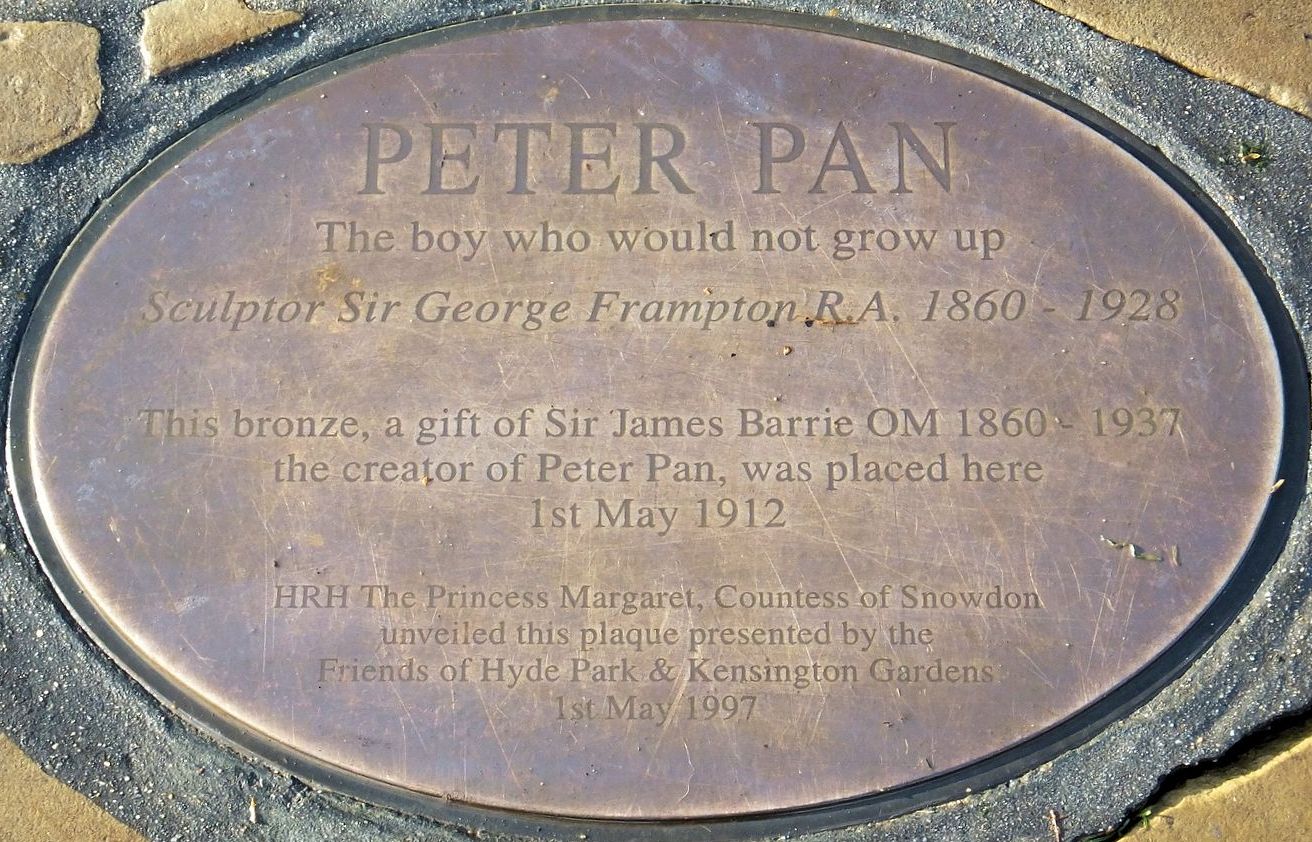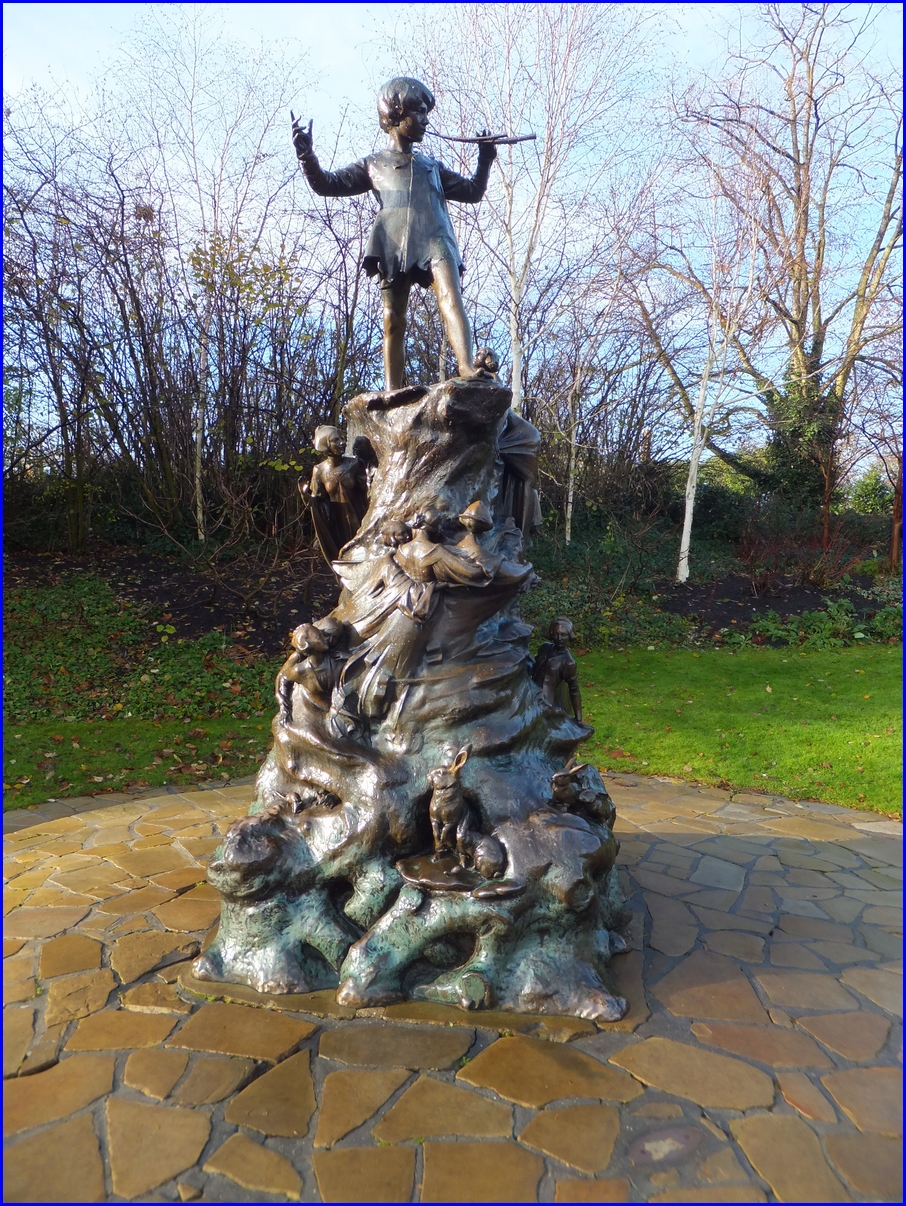|
 Peter Pan Statue - Kensington Gardens, London, UK
N 51° 30.518 W 000° 10.556
30U E 695971 N 5710170
In Kensington Gardens, on the west side of The Long Water, there is a statue of Peter Pan that was gifted by the creator J M Barrie in 1912.
Waymark Code: WMMVQJ
Location: London, United Kingdom
Date Posted: 11/10/2014
Views: 15
The oval, bronze plaque is set into the paving and advises:
Peter Pan
The boy who would not grow up
Sculptor Sir George Frampton RA 1860 - 1928
This bronze, a gift of Sir James Barrie OM 1860 - 1937
the creator of Peter Pan, was placed here
1st May 1912
HRH The Princess margaret, Countess of Snowdon
unveiled this plaque presented by the
Friends of hyde Park & Kensington Gardens
1st May 1997
Wikipedia tells us about Peter Pan sculptures:
The original statue in Kensington Gardens by sculptor George Frampton was commissioned by Barrie and erected overnight on 30 April 1912 as a May Day surprise to the children of London. There are seven statues cast from the original mould. The other six are located in:
- Egmont Park, Brussels, Belgium, 1924
- Bowring Park, St. John's, Newfoundland, Canada, Bowring Park, 1925
- Johnson Park, Camden, New Jersey, United States, 1926
- Queens Gardens, Perth, Western Australia, 1927
- Sefton Park, Liverpool, England, 1928
- Glenn Gould Park, Toronto, Ontario, Canada, 1929
A statue by Paul Montfort was commissioned by the town council of Melbourne, Australia, in 1926 and is now situated in Melbourne Zoo.
A statue by Alex Proudfoot RSA, Principal of Glasgow School of Art, was erected at the Mearnskirk Hospital for children in Glasgow in 1949, commissioned by Alfred Ellsworth in memory of his friend Dr John A Wilson, first superintendent of Mearnskirk Hospital, who had been a school friend of J.M. Barrie.
A statue by Ivan Mitford-Barberton was commissioned by Vyvyan and Gwen Watson in remembrance of their son Peter and given in 1959 to the Red Cross War Memorial Children’s Hospital in Western Cape, South Africa.
A pair of statues by Cecil Thomas, one showing Peter Pan and Tinker Bell, and the other Wendy and the Darling children, have been located in Dunedin Botanic Gardens in Dunedin, New Zealand since the 1960s.
Two bronze casts of a statue by Alistair Smart, originally commissioned by the Angus Milling Company in 1972 are in Kirriemuir, Scotland, one in the main town square and the other in the Peter Pan Garden by Barrie's Birthplace, now owned by the National Trust of Scotland.
A bronze statue by Diarmuid Byron O'Connor was commissioned by Great Ormond Street Hospital in London and unveiled in 2000, showing Peter blowing fairy dust, with Tinker Bell added in 2005.
The Encyclopaedia Britannica website tells us about J M Barrie:
 J.M. Barrie, in full Sir James Matthew Barrie, 1st Baronet (born May 9, 1860, Kirriemuir, Angus, Scotland—died June 19, 1937, London, England), Scottish dramatist and novelist who is best known as the creator of Peter Pan, the boy who refused to grow up. J.M. Barrie, in full Sir James Matthew Barrie, 1st Baronet (born May 9, 1860, Kirriemuir, Angus, Scotland—died June 19, 1937, London, England), Scottish dramatist and novelist who is best known as the creator of Peter Pan, the boy who refused to grow up.
The son of a weaver, Barrie never recovered from the shock he received at six from a brother’s death and its grievous effect on his mother, who dominated his childhood and retained that dominance thereafter. Throughout his life Barrie wished to recapture the happy years before his mother was stricken, and he retained a strong childlike quality in his adult personality.
Barrie studied at the University of Edinburgh and spent two years on the Nottingham Journal before settling in London as a freelance writer in 1885. His first successful book, Auld Licht Idylls (1888), contained sketches of life in Kirriemuir, and the stories in A Window in Thurms (1889) continue to explore that setting. The Little Minister (1891), a highly sentimental novel in the same style, was a bestseller, and, after its dramatization in 1897, Barrie wrote mostly for the theatre. His autobiographical novels When a Man’s Single (1888) and Sentimental Tommy (1896) both feature a little boy in Kirriemuir (“Thrums”) who weaves a cloak of romantic fiction between himself and reality and becomes a successful writer. Most of these early works are marked by quaint Scottish dialect, whimsical humour and comic clowning, pathos, and sentimentality.
 Barrie’s marriage in 1894 to the actress Mary Ansell was childless and apparently unconsummated. In 1897 he formed an attachment to Sylvia Llewellyn Davies, and it was to her sons, through whom he began to live again the experience of childhood, that he told his first Peter Pan stories, some of which were published in The Little White Bird (1902). The play Peter Pan, the Boy Who Wouldn’t Grow Up, was first produced in 1904. This play added a new character to the mythology of the English-speaking world in the figure of Peter Pan, and its theme of heroic boyhood triumphant over the seedy, middle-aged pirate Captain Hook proved to have a lasting appeal. Barrie’s idyll of reexperienced boyhood was followed by tragedy. His marriage ended in divorce in April 1910; Sylvia Davies, then a widow, died four months later; and two of her sons, to whom Barrie acted as guardian, were killed. Barrie’s marriage in 1894 to the actress Mary Ansell was childless and apparently unconsummated. In 1897 he formed an attachment to Sylvia Llewellyn Davies, and it was to her sons, through whom he began to live again the experience of childhood, that he told his first Peter Pan stories, some of which were published in The Little White Bird (1902). The play Peter Pan, the Boy Who Wouldn’t Grow Up, was first produced in 1904. This play added a new character to the mythology of the English-speaking world in the figure of Peter Pan, and its theme of heroic boyhood triumphant over the seedy, middle-aged pirate Captain Hook proved to have a lasting appeal. Barrie’s idyll of reexperienced boyhood was followed by tragedy. His marriage ended in divorce in April 1910; Sylvia Davies, then a widow, died four months later; and two of her sons, to whom Barrie acted as guardian, were killed.
Barrie was created a baronet in 1913 and was awarded the Order of Merit in 1922. He became president of the Society of Authors in 1928 and chancellor of the University of Edinburgh in 1930.
 Most of Barrie’s stage triumphs have been dismissed by critics as marred by ephemeral whimsicalities, but at least six of his plays—Quality Street (1901), The Admirable Crichton (1902), What Every Woman Knows (1908), The Twelve-Pound Look (1910), The Will (1913), and Dear Brutus (1917)—are of indisputably high quality. Barrie idealized childhood and desexualized femininity but took a disenchanted view of adult life, as reflected in the gentle melancholy of these works. Sometimes he expressed his disenchantment humorously, as in The Admirable Crichton, in which a butler becomes the king of a desert island, with his former employers as serfs; sometimes satirically, as in The Twelve-Pound Look; and sometimes tragically, as in Dear Brutus, in which nine men and women whose lives have come to grief are given a magical second chance, only to wreck themselves again on the reefs of their own temperaments. The elaborate stage directions in Barrie’s plays are sometimes more rewarding than their dialogue itself. Barrie proved himself a master of stage effects and of the delineation of character, but the sentimental and whimsical elements in his work have discouraged frequent revivals. Most of Barrie’s stage triumphs have been dismissed by critics as marred by ephemeral whimsicalities, but at least six of his plays—Quality Street (1901), The Admirable Crichton (1902), What Every Woman Knows (1908), The Twelve-Pound Look (1910), The Will (1913), and Dear Brutus (1917)—are of indisputably high quality. Barrie idealized childhood and desexualized femininity but took a disenchanted view of adult life, as reflected in the gentle melancholy of these works. Sometimes he expressed his disenchantment humorously, as in The Admirable Crichton, in which a butler becomes the king of a desert island, with his former employers as serfs; sometimes satirically, as in The Twelve-Pound Look; and sometimes tragically, as in Dear Brutus, in which nine men and women whose lives have come to grief are given a magical second chance, only to wreck themselves again on the reefs of their own temperaments. The elaborate stage directions in Barrie’s plays are sometimes more rewarding than their dialogue itself. Barrie proved himself a master of stage effects and of the delineation of character, but the sentimental and whimsical elements in his work have discouraged frequent revivals.
Visit Instructions:
Please provide another photo of the location. You don't have to be in there shot, but you can. The photo requirement is to discourage any armchair visiting.
|